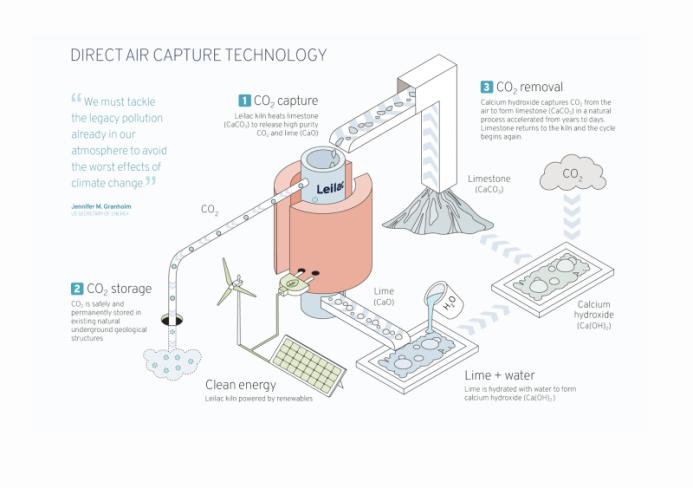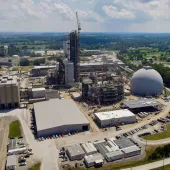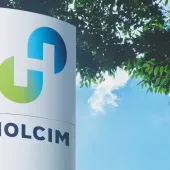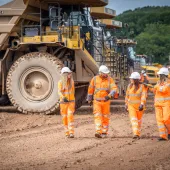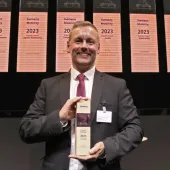Leilac technology to be used to capture atmospheric CO2
Heirloom and Leilac partner to bring lime-based direct air capture technology to market
HEIRLOOM, a direct air capture company permanently removing excess carbon dioxide (CO2) from the atmosphere, and Leilac, a decarbonization technology partner, have signed a Memorandum of Understanding (MoU) for the use of Leilac’s kiln technology in Heirloom’s direct air capture (DAC) solution.
The partnership between Leilac and Heirloom brings together two leading climate technologies to provide an innovative, highly efficient and easily scalable approach to atmospheric carbon dioxide removal by DAC.
The MoU outlines the key terms for a global and binding licence and collaboration agreement, expected to be executed in the coming weeks.
‘We’re incredibly excited about incorporating Leilac’s world-leading electric kiln technology into our DAC facilities because it will accelerate our efforts to capture 1 billion tonnes of CO2 from the atmosphere by 2035, owing to its highly modular and energy-efficient design,’ said Shashank Samala, chief executive officer of Heirloom.
In welcoming the announcement, Leilac chief executive officer, Daniel Rennie said: ‘Leilac is delighted to be partnering with Heirloom. Our partnership will apply Leilac’s core technology for cement and lime decarbonization to address the global challenge of excess atmospheric CO2.
‘Heirloom and Leilac are well matched. Heirloom are a sophisticated and innovative direct air capture company who share our mission to reduce and remove global CO2 emissions. Heirloom use low-cost and abundant limestone, which Leilac’s technology is specifically designed for. Both technologies are modular, easily scalable and can be renewably powered.
‘Over more than eight years, Leilac’s decarbonization technology has been developed for, and in partnership with, the cement and lime industries. Leilac’s pilot plant, Leilac-1, has proven the Leilac technology at a scale significantly beyond all existing DAC facilities. Leilac is well advanced on its pathway to engineering multiple capture facilities each with around one million tonnes of annual CO2 capacity, via the development of a replicable module in Leilac-2.
‘We are grateful to our partners and the investment from the European Union for all we have achieved to date. While industrial decarbonization continues as our core focus, we are very pleased to be able to leverage our technology to help rapidly scale solutions to mitigate the excess carbon dioxide already in our atmosphere.’
Heirloom are developing the fastest path to low-cost, permanent CO2 removal by harnessing limestone. With a cost of approximately US$10 to US$50 per tonne, limestone is inexpensive and easy to source. Combined with highly modular, easy-to-manufacture facilities, Heirloom’s solution is built to scale quickly to meet the urgency of climate action.
Leilac’s calcination technology efficiently separates and captures carbon dioxide from limestone to produce decarbonized lime. Its unique indirect heating approach requires no additional chemicals or processes and can be directly powered by renewable electricity. By keeping the process CO2 emissions pure, Leilac’s technology removes the need to separate gases from gases, enabling it to target the lowest-cost solution for the capture of CO2 from limestone.
Leilac’s technology is proven at pilot scale, including through its Leilac-1 pilot plant in Belgium, and three smaller electric units. In operation since 2019, Leilac-1 has a capture capacity of 25,000 tonnes of CO2 per year and is currently the largest carbon capture installation for cement in the world, outside China.
Leilac-2, a demonstration plant in Germany with a capture capacity of 100,000 tonnes of CO2 per year, is due to open in 2024. Multiple engineering studies are in progression for full-scale installations of the Leilac technology at cement plants with capture capacities of around 1 million tonnes/year of CO2.
The technology partnership leverages eight years of significant investment from the European Union and cement and lime industries to support and progress the DAC industry. Currently, Leilac’s proven capacity is more than double the current combined capture capacity of all DAC facilities globally.
Heirloom’s DAC technology uses lime in a novel carbonation process to directly capture CO2 from the air and form limestone. The process accelerates the natural binding of CO2 and lime from a period of years to just three days.
After binding and removing CO2 from the air, the reformed limestone is fed back into the renewably powered Leilac kiln, where the CO2 is separated and captured, and the cycle begins again.
The CO2 removed from the air will be mineralized, where it is bound to rocks or other materials, or injected underground into existing natural geological structures, where it remains safely and permanently stored.
The integrated Heirloom and Leilac DAC solution will be 100% renewably powered to deliver the maximum net reduction of atmospheric CO2.
Decarbonization across all sectors of the economy is vital to achieving net-zero emissions by 2050 and avoiding the most catastrophic effects of climate change. But to achieve global climate goals, decarbonizing alone will not be enough. It will also be necessary to mitigate the excess CO2 already in the atmosphere.
The Intergovernmental Panel on Climate Change projects that CO2 removal in the order of 1–10 billion tonnes per year could mitigate residual emissions and, in most scenarios, achieve net-negative emissions to return global warming to 1.5 degrees Celsius, following a peak.
Modular, scalable and low-cost DAC technology, paired with geological carbon storage, is said to offer a path to removing ambient CO2 at the gigatonne scale.
Heirloom, whose investors include Bill Gates-backed Breakthrough Energy Ventures, as well as existing Leilac shareholder Carbon Direct Capital Management, Ahren Innovation Capital and Microsoft, are on a mission to remove 1 billion tonnes of CO2 from the atmosphere by 2035.
Leilac’s decarbonization technology was developed for, and in partnership with, the cement and lime industries. It provides an efficient solution for the separation and abatement of unavoidable process emissions released in the production of cement and lime and is designed to be powered by renewable energy sources and clean alternative fuels.
Heirloom will apply the same core Leilac kiln technology for direct air capture of CO2 emissions from the atmosphere. The partnership will also further accelerate development of Leilac’s decarbonization solutions for industrial emissions in cement and lime, helping to pave the way for full-scale industrial electrification and CO2 abatement.
Mr Rennie continued: ‘The collaborative and co-operative approach outlined in this agreement aims to accelerate the learning, synergies and steps to scaling that are needed to achieve our global climate ambitions and commitments. We are very excited to see the results we can achieve together.’

